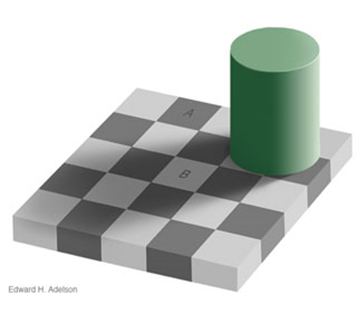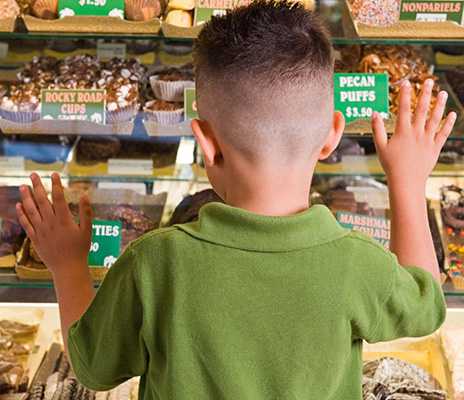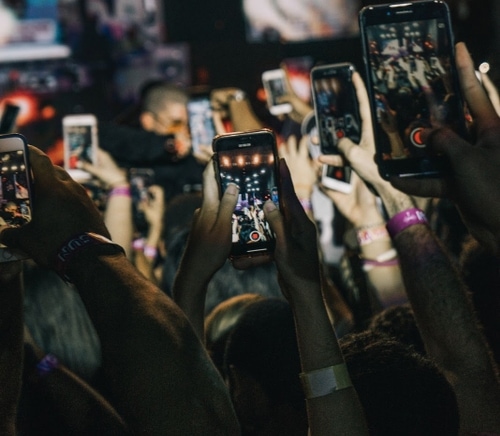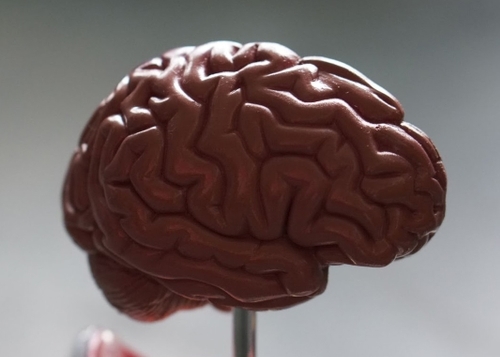Overview
Our minds and bodies keep us safe and healthy, but also have vulnerabilities that can be exploited. Persuasive technology taps into those vulnerabilities, pushing us to keep clicking, scrolling, and engaging.
In this issue guide, you’ll learn:
How our mind and body have natural vulnerabilities.
How persuasive technologies take advantage of those limitations.
The impact of persuasive technologies on our mental health.
By understanding how persuasive technology takes advantage of our vulnerabilities, you’ll see how social media companies neglect their responsibility to care for our well-being.
Introduction

“The first thing I do in the morning is reach for my phone. I’m always on it during school. It's the first thing I look at when I get home.”
At the end of the Persuasive Technology Issue Guide, we asked you to track all the places online you notice persuasive techniques, paying close attention to persuasive technology’s role in your life.
Look back over the observations you recorded. If you’re working in a classroom or group, share your observations with others.
- What was surprising about what you observed?
- What did you notice about the amount of technology you use that can be described as “persuasive?”
- How do you think using persuasive technology this way is affecting you?
- Your experience is one among billions. How do you think using this much persuasive technology is affecting society?
Now let’s look at how persuasive technology, and particularly social media, interacts with our brains. As we do, keep in mind what you’ve observed about all the places persuasive technology shows up in your life and in the world around us.
What are cognitive biases?
“We have a basic biological imperative to connect with other people. That directly affects the release of dopamine in the reward pathway. Millions of years of evolution are behind that system to get us to come together and live in communities, to find mates, to propagate our species. So there’s no doubt that a vehicle like social media, which optimizes this connection between people, is going to have the potential for addiction.”
Our brains use shortcuts to navigate the complex world around us and keep us safe and healthy:
We pay more attention to fearful, dangerous stimuli to stay safe.
We remember things that hurt us more than things that help us so we can predict future consequences.
We tend to follow the popular opinion of those around us to build stronger communities around shared ideas.
But these shortcuts don’t work perfectly in every situation. They can become cognitive biases, or ways in which our brains’ patterns make us vulnerable to errors in judgment, manipulation, and exploitation.
To understand this better, let’s do an experiment. Take a look at the image below. Which labeled square is darker: A or B?

The squares are actually the same color.
The difficulty in identifying this comes from your brain helpfully analyzing the colors, the shadows, and the shapes and viewing the picture as a three-dimensional scene.
Your brain views square B as a light-colored square that happens to be in the green cylinder’s shadow. Your knowledge that squares A and B are the same color doesn’t change your perception.

But when we draw lines of the same color through both squares, the shortcuts your brain was using no longer work. Now the two squares are clearly the same color.
Even if you understand how the trick works, a few carefully chosen design elements (color, shading, shapes, and patterns) take advantage of our brain’s helpful shortcuts for processing what we see. What we perceive to be true depends on the context in which we see it. This is cognitive bias in action.
Let’s look at another example: the Solomon Asch experiment on social conformity. Subjects were asked to match a reference line (on the left) to one of three comparison lines (on the right):

Which comparison line is the same length as the reference line?
The correct answer is Line C. Seems obvious, doesn’t it? People in the experiment correctly matched those two lines more than 99% of the time—when they were on their own.
Do you think you would still have answered C if several other people answered A or B? That’s what the experiment explored. When multiple actors were added, and they gave the wrong line as their answer, over 36% of the experiment participants chose the wrong line!
This finding may be surprising: social reality can override physical reality. This is a form of conformity bias: we tend to want to conform to the social norms around us.
Conformity bias can intersect with confirmation bias—the tendency for our brains to collect evidence that supports our existing viewpoints—compounding our tendency to favor people we already identify with: our friends, family, coworkers, or others who share our interests or opinions. You’re more likely to react favorably to a viewpoint coming from a group you identify with than a group you don’t identify with.
The Solomon Asch experiment on social conformity suggests that without realizing it, many people conform to initial perceptions and social norms, selectively ignoring contradictory evidence.
This has profound implications:
- First, that some people’s behavior can be manipulated by their social environment.
- Second, that the technology that shapes our social environments has immense power over what we say we believe.
- And finally, that our democracies are vulnerable to technologies that manipulate consensus.
How do you see social conformity bias and confirmation bias show up in social media?
Social conformity bias and confirmation bias are important cognitive biases to consider in the context of social media, but they are just two among many. A motivated person or product can trick us in lots of ways, and that happens all the time because—whether it's shocking advertisements, addictive snack foods, or persuasive technology—tricking our brains is highly profitable.
How does social media take advantage of our cognitive vulnerabilities?
“...way too often I find the unconscious part of my brain instinctively clicking on Snapchat and just wasting away time. Our technology and social media can NOT be designed to manipulate and warp our unconscious behavior and decisions.”
We’ve learned that persuasive technology is designed to shape our attitudes and behavior. From features like infinite scroll to algorithmic recommendations, social media presents a special case of persuasive technology where psychological buttons are poked and prodded again and again, often without our awareness.

Our cognitive biases make us vulnerable to these features, leading us to click, scroll, and engage for hours on end. Consider the following ways social media exploits these vulnerabilities:
Creating urgency
Because our attention is a limited resource, at any given moment our brains need to determine what is important. The “salience network” of the brain¹ helps us do that by alerting us to threats and opportunities. Notifications (vibrations, red dots, flashing lights, banners) constantly trigger the salience network. Most notifications are designed to pull us into an app rather than offer important information.Encouraging constant seeking
The brain circuit involved in wanting is much more powerful than the brain circuit involved in satisfaction.² Social media capitalizes on this, providing endless possibilities for seeking in the form of features like infinite scroll, recommendations, and swiping to new content.Engaging with negative content
Have you ever noticed that if you get five positive comments and one negative one you still tend to focus more on the negative? Research shows that negative information gets more attention and shapes emotion and behavior more powerfully than positive information does.³ To keep us safe, our brains process negative information—especially if it causes fear—more quickly and thoroughly than positive information. Social media content that generates fear, anger, or disgust sees higher engagement, and spreads much more quickly, than positive content. Recommendation algorithms often multiply this effect.Comparing ourselves to others
Social media creates an environment in which we are constantly comparing ourselves to others. Our brains pay close attention to information about ourselves, and tend to compare information about ourselves to what we learn about other people so we fit in socially.⁴ Our feeds are filled with highly curated images featuring people in select moments showing only what they want you to see, validated by likes that activate powerful reward circuits in the brain. This environment dramatically escalates the scope and stakes of our comparisons.Isolating us in bubbles
Just as our brains are sensitive to social comparison, they’re also sensitive to social exclusion. Our brains process rejection and physical pain using some of the same neural pathways, meaning that when your feelings “get hurt,” your brain processes it in a similar way to how it processes physical pain.⁵ Social media algorithms take advantage of this vulnerability. They learn about our preferences and curate the information we receive. In our individualized feeds with limited perspectives, we struggle with the fear of rejection (what happens if I say no?).
How does social media impact our behavior?
“It brings us so much comfort that we don't want to understand its harms. I can't name the last time I was truly alone. As soon as I feel uncomfortable, anxious, etc., my phone is my escape. Is that normal? Absolutely not. Do I understand that? 100%. But at the same time, am I still addicted? Unfortunately.”
To understand how social media impacts us better, we first have to understand ourselves better. We are constantly changing, affected each moment by people, environments, and events, in ways we are aware of and in ways we aren’t. Although we often focus on how we are able to shape the world around us, we are also shaped by the conditions we find ourselves in.
Even before we’re born, the genetic material from our parents gives us certain physical and mental characteristics. From birth, we are shaped by every relationship and every conversation we have.
Think about the environment that helped to shape your life: where you live, the schools you’ve attended, and the activities and communities outside of school that you’ve participated in.
- How have you been shaped by these places and communities?
Think about the people in your life, your family, friends, teachers, classmates, and many others.
- How have these people shaped your life?
Think about something you’ve learned that’s important to you.
- How did you learn it?
Think of someone who has shaped your life for the better. Email or call them and tell them what they did for you and how you feel about it.
The people, environments, and experiences that shape us have a set of underlying conditions: values, hopes, beliefs, characteristics, and assumptions. These conditions influence the way we see reality and affect the possibilities for our future.
All this means that we’re always changing, and the influences around us matter enormously. What’s around most of us more consistently than anything or anyone else? Our phones and social media.

When we use social media repeatedly, it begins to train us: our thoughts, feelings, and motivations are shaped by powerful technology designed to keep us engaged. Without even knowing it sometimes, we learn new behaviors and warped values about what’s important, and they stick—even when they’re not good for us. It impacts us both online and offline. For example:
When we are bombarded with notifications, it compromises our ability to attend to what is important.
When endless content creates an overwhelming amount of want, we can end up addicted to seeking satisfaction, clicking and scrolling, mindlessly consuming content, often with minimal oversight from cognitive control regions of the brain. Ultimately, this behavior drains our energy.
When social media forces us to constantly engage in social comparison, we’re filled with negative emotions: envy, shame, anxiety, or conceit.
When we’re frequently exposed to negative content, fear and outrage can become the norm, eroding our sense of goodness and shared humanity.
When algorithms tell us what we want to believe, we become more polarized and shared understanding across society breaks down.
None of this is healthy for us. Social media’s ability to profit from our vulnerabilities is putting our brains— and our society—at risk.
These features show how social media prioritizes profit for tech companies over being sensitive to the intricacies of our brains or the potential impacts on our mental health.
- Keeping in mind what you’ve learned about cognitive biases, what would be different about social media if it was designed to respect our brains’ vulnerabilities?
How does social media impact the brain as it develops?
“I felt trapped because social media was hardwired into my brain as it developed when I was a kid. I didn't sign up for it, and yet here I am 12-ish years later trying to undo things that are inevitably fundamental to who I am.”
“We can confidently say that [social media is] changing the way that teens interact with each other, with peers, with the world, and that those changes and interactions lead to changes in behaviors, changes in psychiatric and mental health.”
The effects of social media on the brain are even more pronounced for young people. Take a look at this bonus clip from The Social Dilemma that summarizes how social media threatens youth mental health.

As discussed in the video, the prefrontal cortex, the area of the brain that helps us process and direct our attention based on our goals, is the last part of our brain to mature. That makes it especially difficult for young people to resist persuasive design—the brain is still developing, so self-awareness and willpower are still building up.

Research on young people’s use of social media reveals that this is creating unique challenges for this generation. Exposure to unrestrained levels of digital technology can have serious long-term consequences for development. Social media can permanently change young people’s brain structure and impact how they will think, feel, and act throughout their lives.⁶ For instance, a National Academy of Sciences working group found that media multitasking among youth is associated with poorer memory, increased impulsivity, and changes in brain function.⁷
Furthermore, the U.S. is in the midst of a youth mental health crisis. While still low, suicide rates increased nearly 60% between 2007 and 2017 among 10-24 year-olds, according to the CDC. Many experts point to the rise of social media around 2009 as a key reason for this increase.
Social media has a powerful impact on young people like you and your peers. Now that we’ve discussed the intersections between social media and the brain, and particularly how our social media taps into our cognitive biases, think about your experiences online.
- What are some ways that you see social media taking advantage of you and those around you?
- How do you think tech companies should react to the research and statistics we’ve discussed?
What happens when we can’t resist persuasive technology?
“The worst part is that I knew what I was doing was wrong, I knew the dangers of the endless scroll, but I still got sucked in.”
“It’s interesting that knowing what was going on behind the curtain, I still wasn’t able to control my usage.”
“Even knowing how these tricks work, I’m still susceptible to them. I’ll still pick up the phone, and 20 minutes will disappear.”
We’ll never be fully free of our biases in cognition and perception; they’re part of being human and we need them to survive. As the quotes above indicate, we are all susceptible to these effects, even those who created these technologies in the first place.
We began this discussion by looking at how prevalent persuasive technology is in our daily lives. When we look at the intersections between the brain and these technologies, we can see that giant social media companies grew so quickly because they mastered how to hack our brains.
We are all affected by technology to different degrees. We can find ways to resist its effects. But persuasive technologies are constantly getting better at finding our vulnerabilities and taking advantage of them to keep us engaged and influence our behavior. As social media takes on a bigger role in the world—how we connect online, how we get information, who we vote for—it shapes more and more of what we're thinking and feeling. Even if we know it’s happening, we end up with less and less control over who we are and what we really believe.
To explore these consequences, let’s again take a closer look at our own experiences.
In a notebook, create a simple chart like this one:
App |
Time of Day/Time Used |
Observations |
How it Made Me Feel |
|---|---|---|---|
|
Snapchat |
Morning/30 minutes |
I wanted to do my homework, but I kept getting notified to keep talking to my friend |
I was frustrated that I couldn't just ignore it |
|
After school/An hour, in and out |
A group of friends took selfies showing off new makeup |
I felt bad that I can’t afford new makeup, and stressed about how tired I looked |
|
| TikTok |
In bed/An hour, in and out |
I got sucked in by a live video of a user I'd never seen before, and then I clicked to other similar issues |
It was really entertaining, but then I couldn’t sleep and I felt tired and unfocused the next day |
Use this chart to help you think through what is happening while you’re on social media. Keep track for 24 hours or a week. Be honest with yourself about what you’re experiencing.
We’ll reflect on what you observe at the beginning of the next Issue Guide.
Go Deeper
Listen to social psychologist Jonathan Haidt on the Center for Humane Technology’s Your Undivided Attention podcast. Jonathan discusses his work with fellow psychologist Jean Twenge that shows the connection between the youth mental health crisis and the rise of social media use.